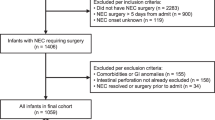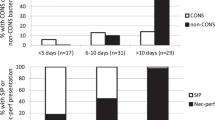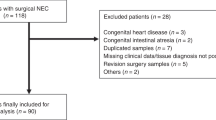Abstract
Introduction:
Necrotizing enterocolitis (NEC) and focal intestinal perforation (FIP) are neonatal intestinal emergencies that affect premature infants. Although most cases of early NEC can be successfully managed with medical therapy, prompt surgical intervention is often required for advanced or perforated NEC and FIP.
Methods:
The surgical management and treatment of FIP and NEC are discussed on the basis of literature review and our personal experience.
Results:
Surgical options are diverse, and include peritoneal drainage, laparotomy with diverting ostomy alone, laparotomy with intestinal resection and primary anastomosis or stoma creation, with or without second-look procedures.
Conclusions:
The optimal surgical therapy for FIP and NEC begins with prompt diagnosis and adequate fluid resuscitation. It appears that there is no significant difference in patient outcome based on surgical management alone. However, the infant's weight, comorbidities, surgeon preference and timing of intervention should be taken into account before operative intervention.
This is a preview of subscription content, access via your institution
Access options
Subscribe to this journal
Receive 12 print issues and online access
$259.00 per year
only $21.58 per issue
Buy this article
- Purchase on Springer Link
- Instant access to full article PDF
Prices may be subject to local taxes which are calculated during checkout

Similar content being viewed by others
References
Stoll BJ . Epidemiology of necrotizing enterocolitis. Clin Perinatol 1994; 21: 205–218.
Maayan-Metzger A, Itzchak A, Mazkereth R, Kuint J . Necrotizing enterocolitis in full-term infants: case-control study and review of the literature. J Perinatol 2004; 24: 494–499.
Henry MC, Moss RL . Current issues in the management of necrotizing enterocolitis. Semin Perinatol 2004; 28: 221–233.
Hsueh W, Caplan MS, Qu XW, Tan XD, De Plaen IG, Gonzalez-Crussi F . Neonatal necrotizing enterocolitis: clinical considerations and pathogenetic concepts. Pediatr Dev Pathol 2003; 6: 6–23.
Okuyama H, Kubota A, Oue T, Kuroda S, Ikegami R, Kamiyama M . A comparison of the clinical presentation and outcome of focal intestinal perforation and necrotizing enterocolitis in very-low-birth-weight neonates. Pediatr Surg Int 2002; 18: 704–706.
Mintz AC, Applebaum H . Focal gastrointestinal perforations not associated with necrotizing enterocolitis in very low birth weight neonates. J Pediatr Surg 1993; 28: 857–860.
Morecroft JA, Spitz L, Hamilton PA, Holmes SJ . Necrotizing enterocolitis—multisystem organ failure of the newborn? Acta Paediatr 1994; 396 (Suppl): 21–23.
Bell MJ, Ternberg JL, Feigin RD, Keating JP, Marshall R, Barton L et al. Neonatal necrotizing enterocolitis. Therapeutic decisions based upon clinical staging. Ann Surg 1978; 187: 1–7.
Kurscheid T, Holschneider AM . Necrotizing enterocolitis (NEC)—mortality and long-term results. Eur J Pediatr Surg 1993; 3: 139–143.
Tatekawa Y, Muraji T, Imai Y, Nishijima E, Tsugawa C . The mechanism of focal intestinal perforations in neonates with low birth weight. Pediatr Surg Int 1999; 15: 549–552.
Stark AR, Carlo WA, Tyson JE, Papile LA, Wright LL, Shankaran S et al. Adverse effects of early dexamethasone in extremely-low-birth-weight infants. National Institute of Child Health and Human Development Neonatal Research Network. N Engl J Med 2001; 344: 95–101.
Tam AL, Camberos A, Applebaum H . Surgical decision making in necrotizing enterocolitis and focal intestinal perforation: predictive value of radiologic findings. J Pediatr Surg 2002; 37: 1688–1691.
Blakely ML, Lally KP, McDonald S, Brown RL, Barnhart DC, Ricketts RR et al. Postoperative outcomes of extremely low birth-weight infants with necrotizing enterocolitis or isolated intestinal perforation: a prospective cohort study by the NICHD Neonatal Research Network. Ann Surg 2005; 241: 984–989; discussion 989–994.
Ade-Ajayi N, Kiely E, Drake D, Wheeler R, Spitz L . Resection and primary anastomosis in necrotizing enterocolitis. J R Soc Med 1996; 89: 385–388.
Weber TR, Lewis JE . The role of second-look laparotomy in necrotizing enterocolitis. J Pediatr Surg 1986; 21: 323–325.
Vaughan WG, Grosfeld JL, West K, Scherer LR, Villamizar E, Rescorla FJ . Avoidance of stomas and delayed anastomosis for bowel necrosis: the ‘clip and drop-back’ technique. J Pediatr Surg 1996; 31: 542–545.
Luzzatto C, Previtera C, Boscolo R, Katende M, Orzali A, Guglielmi M . Necrotizing enterocolitis: late surgical results after enterostomy without resection. Eur J Pediatr Surg 1996; 6: 92–94.
Moore TC . Successful use of the ‘patch, drain, and wait’ laparotomy approach to perforated necrotizing enterocolitis: is hypoxia-triggered ‘good angiogenesis’ involved? Pediatr Surg Int 2000; 16: 356–363.
Parigi GB, Bragheri R, Minniti S, Verga G . Surgical treatment of necrotizing enterocolitis: when? how? Acta Paediatr 1994; 396 (Suppl): 58–61.
Cooper A, Ross AJ, O'Neill JA, Schnaufer L . Resection with primary anastomosis for necrotizing enterocolitis: a contrasting view. J Pediatr Surg 1988; 23: 64–68.
Cass DL, Brandt ML, Patel DL, Nuchtern JG, Minifee PK, Wesson DE . Peritoneal drainage as definitive treatment for neonates with isolated intestinal perforation. J Pediatr Surg 2000; 35: 1531–1536.
Morgan LJ, Shochat SJ, Hartman GE . Peritoneal drainage as primary management of perforated NEC in the very low birth weight infant. J Pediatr Surg 1994; 29: 310–314; discussion 314–315.
Lessin MS, Luks FI, Wesselhoeft CW, Gilchrist BF, Iannitti D, DeLuca FG . Peritoneal drainage as definitive treatment for intestinal perforation in infants with extremely low birth weight (<750 g). J Pediatr Surg 1998; 33: 370–372.
Ein SH, Marshall DG, Girvan D . Peritoneal drainage under local anesthesia for perforations from necrotizing enterocolitis. J Pediatr Surg 1977; 12: 963–967.
Rovin JD, Rodgers BM, Burns RC, McGahren ED . The role of peritoneal drainage for intestinal perforation in infants with and without necrotizing enterocolitis. J Pediatr Surg 1999; 34: 143–147.
Ahmed T, Ein S, Moore A . The role of peritoneal drains in treatment of perforated necrotizing enterocolitis: recommendations from recent experience. J Pediatr Surg 1998; 33: 1468–1470.
Demestre X, Ginovart G, Figueras-Aloy J, Porta R, Krauel X, Garcia-Alix A et al. Peritoneal drainage as primary management in necrotizing enterocolitis: a prospective study. J Pediatr Surg 2002; 37: 1534–1539.
Moss RL, Dimmitt RA, Henry MC, Geraghty N, Efron B . A meta-analysis of peritoneal drainage versus laparotomy for perforated necrotizing enterocolitis. J Pediatr Surg 2001; 36: 1210–1213.
Moss RL, Dimmitt RA, Barnhart DC, Sylvester KG, Brown RL, Powell DM et al. Laparotomy versus peritoneal drainage for necrotizing enterocolitis and perforation. N Engl J Med 2006; 354: 2225–2234.
Horwitz JR, Lally KP, Cheu HW, Vazquez WD, Grosfeld JL, Ziegler MM . Complications after surgical intervention for necrotizing enterocolitis: a multicenter review. J Pediatr Surg 1995; 30: 994–998; discussion 998–999.
Janik JS, Ein SH, Mancer K . Intestinal stricture after necrotizing enterocolitis. J Pediatr Surg 1981; 16: 438–443.
Blakely ML, Tyson JE, Lally KP, McDonald S, Stoll BJ, Stevenson DK et al. Laparotomy versus peritoneal drainage for necrotizing enterocolitis or isolated intestinal perforation in extremely low birth weight infants: outcomes through 18 months adjusted age. Pediatrics 2006; 117: e680–e687.
Author information
Authors and Affiliations
Corresponding author
Rights and permissions
About this article
Cite this article
Hunter, C., Chokshi, N. & Ford, H. Evidence vs experience in the surgical management of necrotizing enterocolitis and focal intestinal perforation. J Perinatol 28 (Suppl 1), S14–S17 (2008). https://doi.org/10.1038/jp.2008.44
Published:
Issue Date:
DOI: https://doi.org/10.1038/jp.2008.44
Keywords
This article is cited by
-
Quantitative evaluation of pediatric umbilical loop stomas: 2 decades of experience from a single institution
Pediatric Surgery International (2023)
-
Development of artificial neural networks for early prediction of intestinal perforation in preterm infants
Scientific Reports (2022)
-
Management of neonatal spontaneous intestinal perforation by peritoneal needle aspiration
Journal of Perinatology (2018)
-
Neonatal independent predictors of severe NEC
Pediatric Surgery International (2018)
-
A sutureless technique using cyanoacrylate adhesives when creating a stoma for extremely low birth weight infants
SpringerPlus (2016)



